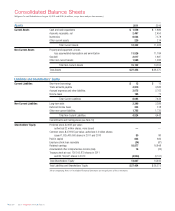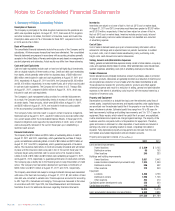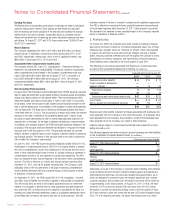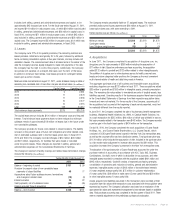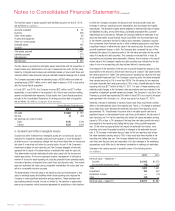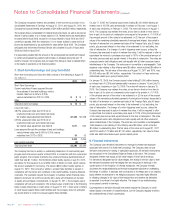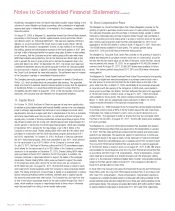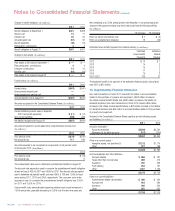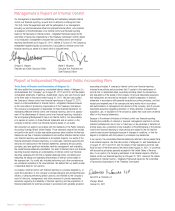Walgreens 2011 Annual Report Download - page 38
Download and view the complete annual report
Please find page 38 of the 2011 Walgreens annual report below. You can navigate through the pages in the report by either clicking on the pages listed below, or by using the keyword search tool below to find specific information within the annual report.Notes to Consolidated Financial Statements (continued)
knowledge, management does not expect reasonably possible losses relating to the
outcome of current litigation and legal proceedings, after consideration of applicable
reserves and rights to indemnification, to be material to the Company’s consolidated
financial position.
On August 31, 2009, a Walgreen Co. shareholder named Dan Himmel filed a lawsuit,
purportedly on the Company’s behalf, against several current and former officers
and directors (each, an “Individual Defendant”). The case was captioned Himmel v.
Wasson, et. al. and was filed in the Circuit Court of Lake County, Illinois. Himmel
alleged that the Company’s management: (i) knew, or was reckless in not knowing,
that selling, general and administrative expenses in the fourth quarter of 2007 were
too high, in light of decreased profits from generic drug sales; (ii) knew, or was reckless
in not knowing, that the Company would not realize gross profits near what many
Wall Street analysts were predicting; and (iii) the directors and officers had a duty
both to prevent the drop in gross profits and to disclose the expected drop to the
public and failed to do either. On September 28, 2011, the Circuit Court approved
a settlement agreement among the parties pursuant to which the Company agreed
to pay an amount in respect of plaintiff’s attorneys’ fees and litigation expenses and
the Circuit Court dismissed the case with prejudice. The settlement was not material
to the Company’s business or consolidated financial position.
The Company previously guaranteed a credit agreement on behalf of SureScripts-
RxHub, LLC, which provides electronic prescription data services. The guarantee
arose as a result of a business decision between parties to ensure that the operations
of SureScripts-RxHub, LLC would have additional support to access financing.
The liability was $10 million at August 31, 2010. In the third quarter of the current
fiscal year, the Company was fully released from its guarantee obligation.
11. Capital Stock
On October 14, 2009, the Board of Directors approved a long-term capital policy
to maintain a strong balance sheet and financial flexibility; reinvest in its core strategies;
invest in strategic opportunities that reinforce its core strategies and meet return
requirements; and return surplus cash flow to shareholders in the form of dividends
and share repurchases over the long term. In connection with the Company’s
capital policy, its Board of Directors authorized a share repurchase program (2009
repurchase program) and set a long-term dividend payout ratio target between 30
and 35 percent of net income. The 2009 repurchase program, which was completed
in September 2010, allowed for the repurchase of up to $2.0 billion of the
Company’s common stock. Shares totaling $360 million and $1,640 million were
purchased in conjunction with the 2009 repurchase program during fiscal 2011
and 2010, respectively. On October 13, 2010, the Board of Directors authorized
the 2011 repurchase program, which was completed in July 2011, which allowed
for the repurchase of up to $1.0 billion of the Company’s common stock.
On July 13, 2011, the Board of Directors authorized the 2012 repurchase program,
which allows for the repurchase of up to $2.0 billion of the Company’s common
stock prior to its expiration on December 31, 2015. Shares totaling $424 million
were purchased in fiscal 2011 related to the 2012 program. In addition, the
Company continues to repurchase shares to support the needs of the employee
stock plans. Shares totaling $244 million were purchased to support the needs
of the employee stock plans during the current fiscal year as compared to
$116 million last year. At August 31, 2011, 65,846,553 shares of common stock
were reserved for future issuances under the Company’s various employee benefit
plans. The timing and amount of repurchases is based on an assessment of various
factors including prevailing market conditions, alternate uses of capital, liquidity,
the economic environment and other factors. The Company has, and may from time
to time in the future, repurchase shares on the open market through Rule 10b5-1
plans, which enable a company to repurchase shares at times when it otherwise
might be precluded from doing so under insider trading laws.
12. Stock Compensation Plans
The Walgreen Co. Stock Purchase/Option Plan (Share Walgreens) provides for the
granting of options to purchase common stock over a 10-year period to eligible
non-executive employees upon the purchase of Company shares, subject to certain
restrictions. Employees may purchase Company shares through cash purchases or
loans. The option price is the closing price of a share of common stock on the grant
date. Options may be granted under this Plan until September 30, 2012, for an
aggregate of 42,000,000 shares of common stock. At August 31, 2011, there were
13,166,886 shares available for future grants. The options granted during
fiscal 2011, 2010 and 2009 have a three-year vesting period.
The Walgreen Co. Executive Stock Option Plan provides for the granting of options to
eligible key employees to purchase common stock over a 10-year period, at a price
not less than the fair market value on the date of the grant. Under this Plan, options
may be granted until January 13, 2020, for an aggregate of 63,400,000 shares of
common stock. At August 31, 2011, 20,663,973 shares were available for future
grants. The options granted during fiscal 2011, 2010 and 2009 have a three-year
vesting period.
The Walgreen Co. Broad Based Employee Stock Option Plan provides for the granting
of options to eligible non-executive employees to purchase common stock over a
ten-year period, at a price not less than the fair market value on the date of the
grant. Under this Plan, on March 11, 2003, substantially all non-executive employees,
in conjunction with the opening of the Company’s 4,000th store, were granted a
stock option to purchase 100 shares. The Plan authorized the grant of an aggregate
of 15,000,000 shares of common stock. At August 31, 2011, 7,833,423 shares
were available for future grants. The options vested and became exercisable on
March 11, 2006, and any unexercised options will expire on March 10, 2013,
subject to earlier termination if the optionee’s employment ends.
The Walgreen Co. 1982 Employees Stock Purchase Plan permits eligible employees
to purchase common stock at 90% of the fair market value at the date of purchase.
Employees may make purchases by cash, loans or payroll deductions up to
certain limits. The aggregate number of shares that may be purchased under
this Plan is 94,000,000. At August 31, 2011, 18,500,086 shares were available
for future purchase.
The Walgreen Co. Long-Term Performance Incentive Plan (amended and restated
Restricted Performance Share Plan) was approved by the shareholders on January
10, 2007. The Plan offers performance-based incentive awards and equity-based
awards to key employees. The awards are subject to restrictions as to continuous
employment except in the case of death, normal retirement or total and permanent
disability. Restrictions generally lapse over a multiyear period from the date of grant.
The Long-Term Performance Incentive Plan was authorized to grant an aggregate
of 10,000,000 shares of common stock. As of August 31, 2011, 5,682,185 shares
were available for future issuance under the Long-Term Performance Incentive Plan.
In accordance with ASC Topic 718, Compensation – Stock Compensation, compen-
sation expense is recognized on a straight-line basis over the employee’s vesting
period or to the employee’s retirement eligible date, if earlier. Compensation expense
related to the Plan was $1 million in fiscal 2011. This compares to $3 million in
fiscal 2010 and $6 million in fiscal 2009.
In fiscal 2009, the Company introduced the Restricted Stock Unit and Performance
Share Plans under the Long-Term Performance Incentive Plan. In accordance with
ASC Topic 718, Compensation – Stock Compensation, compensation expense is
recognized on a straight-line basis based on a three-year cliff vesting schedule for the
annual restricted stock units and straight line over a three-year vesting schedule for the
performance shares. The Company recognized $45 million, $18 million and $12 million
of expense related to these plans in fiscal years 2011, 2010 and 2009, respectively.
Page 36 2011 Walgreens Annual Report


